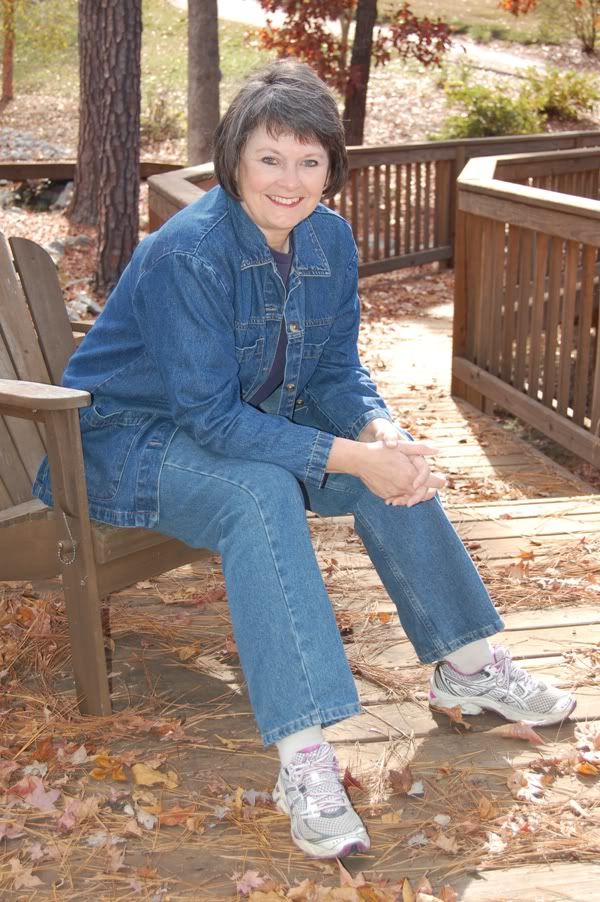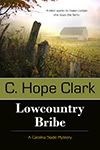 Carolina Slade – Gumshoe Momma
Carolina Slade – Gumshoe Momma
By C. Hope Clark
The main character of A Lowcountry Bribe is Carolina Slade, a lady near and dear to my heart. I named her after doing genealogy research on the Mississippi side of my family. She’s a compilation of folks I’ve admired in my life, from the white streak in her hair taken from one of my aunts to the brashness of my father. Her last name comes from a great grandmother on my mother’s side, and her first name is where she plants her roots. But debutante she ain’t, and that more or less defines me.
My family is Southern. My grandfather farmed cotton in the Mississippi Delta, and I chased feral cats in his barn as a kid. I spent time in Georgia, Alabama, and then two decades in South Carolina assisting farmers via the Department of Agriculture in my adulthood as a result of those early agriculture experiences. Nothing gives me more pleasure than nature, and I’ve tried to infuse that sense into these books as well. So many novels these days tend to be urban, and I wanted to provide a taste of rural into the literary world. No car chases through alleys and on Interstates. Maybe along a two-lane back road, but way more than a spitting distance from any city.
But maybe most unusual of all, I defied the unwritten rule of the proverbial female sleuth. I gave Carolina Slade kids. Not grown children and not nieces who really didn’t belong under the same roof. No. I thrust upon Slade the responsibilities, pains, and joys of being an active mother.
Instantly, my sleuth morphs into a lightweight in the minds of many old-fashioned mystery readers. She can’t travel the world undercover up to her pretty neck in espionage because who would pick up the kids from school? How would she ferret out an evasive criminal and be home for dinner? Where would she keep her .38 so the kids didn’t get their hands on it?
The mystery genre does not lend itself to married women, much less women with kids. Women, however, don’t spit out babies and lose their ability to decrypt problems. Quite the contrary. Who finds the soccer ball, blue tank top, missing car payment or car keys? Who juggles work, school, social engagements and finances, solving everyone’s conundrum before making a to-do list for the next day?
In most best-seller mysteries, the protagonist is a damaged, single male with a girl he can barely hold onto or loses by the end of the story. His life is in crisis. Solving the crime is his twenty-four-hour life, and his social world limps into nonexistence as his sidekick tells him to find balance. He’s stressed, probably drinking heavily, with so much on his plate. Oh, please.
The problem is, women detective characters aren’t much different. Sue Grafton’s alphabet mystery series feature Kinsey Millhone, a private investigator who lives alone, visits her eighty-year-old neighbor for pastries, cleans her apartment for personal entertainment, and fears relationships. The author explains in interviews that Kinsey has to hit the road on a case with little notice, and calling home to make arrangements waters down the intrigue. Thus, no kid baggage.
Patricia Cornwell’s Kay Scarpetta is a divorced, childless, medical examiner. The closest parental trait she shows is acting matronly around her niece Lucy.
Deborah Knott, the character in Margaret Maron’s North Carolina mystery series, is a judge and amateur detective. No urchins in her house.
Sara Paretsky, who originated the female sleuth, pulling women out of the vamp or victim role in mysteries in the 80’s, is known for her V I Warshawski character, a divorced private investigator. While Sara broke the mold for women authors and their characters in the mystery world, her character may have stereotyped female gumshoes as uninvolved and unattached, just like the men that preceded them.
One wonders if the mystery world envisions the womb connected to the brain, and once one is engaged, the other reverts to neutral. Yes, the story stretches an author’s muse when one tosses in the rug rats. It’s harder to make the timeline work when the principal calls to say Johnny got caught fighting on the playground. Of course, babysitting challenges the flow of events. But in reality, are all crime solvers single and footloose without familial obligations?
Police women have children. Detectives have children. Inquisitive females in all walks of life continue to function with kids, as do the fathers. So why can’t we have sleuths who’ve given birth, or more so, have a family life?
A few female writers dare to incorporate children in their protag’s world. Joan Hess writes the Claire Malloy series involving a teenage daughter. Terris McMahan Grimes created the Theresa Galloway series in which a professional married woman balances two children and an elderly mother. Bravo.
Still, the search for mother gumshoes takes serious search time, and even then, the author names pale in comparison to those who prefer their sleuths single and detached. My own writers’ group told me to think twice about inserting a six-year-old son and eleven-year-old daughter in my stories.
“What if she has to leave town?”
“What does she tell her children about what she does?”
“What if she gets hurt?”
“How could she concentrate if her child has an achievement test the next day?”
Yes, those were actual questions from fellow writers. Come on, people. We procreate. We even like the little boogers. If a mother can hold a position as attorney, real estate agent, teacher, doctor or CEO, why can’t she beat the pavement, investigate murders, wade into mayhem, then go home and check homework? What, you can’t imagine someone shooting at her? Ever seen a soccer mom?
C. Hope Clark thrives on the banks of Lake Murray in central South Carolina, often reading her chapters aloud to her Federal agent husband, both while sipping on a good bourbon. Some of her best friends are Dominiquers hens and Buff Orpington roosters who keep her company in Hope’s custom-made coops. Find her FundsforWriters side at www.fundsforwriters.com and author persona at www.chopeclark.com . She blogs at www.hopeclark.blogspot.com and can be found at https://www.facebook.com/chopeclark and on Twitter at @hopeclark. Hope has published in Writer’s Digest, The Writer Magazine, TURF Magazine, Landscape Management, numerous Chicken Soups and many other print and online publications. She speaks frequently at writers conferences throughout the country.


8 Responses to “CAROLINA SLADE- GUMSHOE MOMMA”